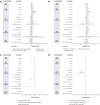Declining trends in vaccine confidence across sub-Saharan Africa: A large-scale cross-sectional modeling study
- PMID: 37290478
- PMCID: PMC10294724
- DOI: 10.1080/21645515.2023.2213117
Declining trends in vaccine confidence across sub-Saharan Africa: A large-scale cross-sectional modeling study
Abstract
Current WHO/UNICEF estimates of routine childhood immunization coverage reveal the largest sustained decline in uptake in three decades with pronounced setbacks across Africa. Although the COVID-19 pandemic has induced significant supply and delivery disruptions, the impact of the pandemic on vaccine confidence is less understood. We here examine trends in vaccine confidence across eight sub-Saharan countries between 2020 and 2022 via a total of 17,187 individual interviews, conducted via a multi-stage probability sampling approach and cross-sectional design and evaluated using Bayesian methods. Multilevel regression combined with poststratification weighting using local demographic information yields national and sub-national estimates of vaccine confidence in 2020 and 2022 as well as its socio-demographic associations. We identify declines in perceptions toward the importance of vaccines for children across all eight countries, with mixed trends in perceptions toward vaccine safety and effectiveness. We find that COVID-19 vaccines are perceived to be less important and safe in 2022 than in 2020 in six of the eight countries, with the only increases in COVID-19 vaccine confidence detected in Ivory Coast. There are substantial declines in vaccine confidence in the Democratic Republic of Congo and South Africa, notably in Eastern Cape, KwaZulu-Natal, Limpopo, and Northern Cape (South Africa) and Bandundu, Maniema, Kasaï-Oriental, Kongo-Central, and Sud-Kivu (DRC). While over 60-year-olds in 2022 have higher vaccine confidence in vaccines generally than younger age groups, we do not detect other individual-level socio-demographic associations with vaccine confidence at the sample sizes studied, including sex, age, education, employment status, and religious affiliation. Understanding the role of the COVID-19 pandemic and associated policies on wider vaccine confidence can inform post-COVID vaccination strategies and help rebuild immunization system resilience.
Keywords: Africa; Bayesian statistics; COVID-19; vaccine confidence; vaccine hesitancy.
Conflict of interest statement
Within the last two years, HJL was involved in collaborative grants with GlaxoSmithKline, Merck and Johnson & Johnson. HJL has also received other support for participating in Merck meetings and GlaxoSmithKline advisory round tables. Within the last two years, AdF has been funded by the Merck Investigator Studies Program and has performed consultancy work for Pfizer Inc.
Figures




Similar articles
-
COVID-19 vaccine acceptance and its socio-demographic and emotional determinants: A multi-country cross-sectional study.Vaccine. 2023 Jan 9;41(2):354-364. doi: 10.1016/j.vaccine.2022.10.051. Epub 2022 Nov 10. Vaccine. 2023. PMID: 36414475 Free PMC article.
-
Forecasting sub-national trends in COVID-19 vaccine uptake in the UK before vaccine rollout.Sci Rep. 2022 Dec 13;12(1):21529. doi: 10.1038/s41598-022-25354-4. Sci Rep. 2022. PMID: 36513741 Free PMC article.
-
Analysis of Perception, Reasons, and Motivations for COVID-19 Vaccination in People with Diabetes across Sub-Saharan Africa: A Mixed-Method Approach.Int J Environ Res Public Health. 2022 Jun 27;19(13):7875. doi: 10.3390/ijerph19137875. Int J Environ Res Public Health. 2022. PMID: 35805551 Free PMC article.
-
COVID-19 vaccine hesitancy in South Africa: how can we maximize uptake of COVID-19 vaccines?Expert Rev Vaccines. 2021 Aug;20(8):921-933. doi: 10.1080/14760584.2021.1949291. Epub 2021 Jul 12. Expert Rev Vaccines. 2021. PMID: 34252336 Review.
-
Challenges and strategies for sustainable and resilient immunization systems in sub-Saharan Africa: A comprehensive scoping review.Vaccine. 2025 Jan 25;45:126639. doi: 10.1016/j.vaccine.2024.126639. Epub 2024 Dec 23. Vaccine. 2025. PMID: 39719771
Cited by
-
Recent trends in vaccine coverage and confidence: A cause for concern.Hum Vaccin Immunother. 2023 Aug 1;19(2):2237374. doi: 10.1080/21645515.2023.2237374. Hum Vaccin Immunother. 2023. PMID: 37526111 Free PMC article.
-
Global socioeconomic inequalities in vaccination coverage, supply, and confidence.NPJ Vaccines. 2025 May 9;10(1):91. doi: 10.1038/s41541-025-01143-8. NPJ Vaccines. 2025. PMID: 40346086 Free PMC article.
-
Exploring perceptions and attitudes towards vaccines in a remote western DRC health zone.Vaccine X. 2024 Dec 4;22:100592. doi: 10.1016/j.jvacx.2024.100592. eCollection 2025 Jan. Vaccine X. 2024. PMID: 39759568 Free PMC article.
-
Global prevalence and correlates of mpox vaccine acceptance and uptake: a systematic review and meta-analysis.Commun Med (Lond). 2024 Jul 9;4(1):136. doi: 10.1038/s43856-024-00564-1. Commun Med (Lond). 2024. PMID: 38977752 Free PMC article.
-
Presidents and vaccines: head of state inoculation as a tool for vaccine promotion.Front Public Health. 2024 May 14;12:1364927. doi: 10.3389/fpubh.2024.1364927. eCollection 2024. Front Public Health. 2024. PMID: 38808000 Free PMC article.
References
-
- World Health Organization . Progress and challenges with achieving universal immunization coverage: technical document [Internet]. 2022. [accessed 2022 Sept 15]. https://www.who.int/publications/m/item/progress-and-challenges.
-
- CDC . Measles in Africa [Internet]. 2022. [accessed 2022 Nov 23]. https://wwwnc.cdc.gov/travel/notices/watch/measles-africa.
-
- WHO Africa . Vaccine-preventable disease outbreaks on the rise in Africa [Internet]. 2022. [accessed 2022 Nov 23]. https://www.afro.who.int/news/vaccine-preventable-disease-outbreaks-rise....
Publication types
MeSH terms
Substances
LinkOut - more resources
Full Text Sources
Other Literature Sources
Medical
